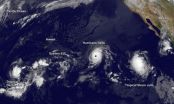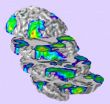Earlier intervention for common form of heart attack linked to improved survival
2014-08-04
(Press-News.org) Changes in the treatment of the most common form of heart attack over the past decade have been associated with higher survival rates for men and women regardless of age, race and ethnicity, according to a UCLA-led analysis.
But the study also suggests that there is room for improvement in how current treatment guidelines are applied among specific patient groups.
The researchers reviewed records for 6.5 million people who were treated for heart attacks between 2002 and 2011. The analysis was among the first and largest national studies to assess the impact of the trend toward more aggressive care for patients who experience the type of heart attack known as non-ST elevation myocardial infarction, or NSTEMI.
Their findings are reported in the current online edition of the peer-reviewed Journal of the American Heart Association.
"The substantial reductions in in-hospital mortality observed for NSTEMI patients nationwide over the last decade reflect greater adherence to evidence-based, guideline-directed therapies," said Dr. Gregg C. Fonarow, the study's senior author and UCLA's Eliot Corday Professor of Cardiovascular Medicine and Science.
"Nevertheless, there may be further opportunities to improve care and outcomes for patients with NSTEMI, who represent the greater proportion of patients presenting with myocardial infarction," said Fonarow, who also is director of the Ahmanson–UCLA Cardiomyopathy Center at the David Geffen School of Medicine at UCLA.
Heart attacks are broadly classified into two types. The more severe form, ST-elevation myocardial infarction (STEMI), involves complete blockage of an artery supplying blood to the heart muscle. The less severe type, NSTEMI, involves partial or temporary blockage of the artery. Studies in the U.S. and Europe have found that although the incidence of STEMI heart attacks is declining, the number of NSTEMI heart attacks increased in the past decade.
Guidelines issued in 2012 by the American College of Cardiology and American Heart Association recommended initiating cardiac catheterization in high-risk NSTEMI patients within 12 to 24 hours after the patient arrives at the hospital. This strategy had been evolving since 2009 following publication of the Timing of Intervention in Acute Coronary Syndromes trial. Previously, the recommendation was to begin catheterization in high-risk NSTEMI patients within 48 hours.
Fonarow and his colleagues examined trends in the use of cardiac catheterization for people who had been hospitalized after suffering an NSTEMI, within 24 hours and within 48 hours of presentation, seeking to determine whether changes in their care may have resulted in better outcomes.
The researchers analyzed publicly available records from the Nationwide Inpatient Sample, the largest U.S. database of hospitalized individuals. Of the 6.5 million patients whose records they examined, 3.98 million were admitted to hospitals with NSTEMI diagnoses.
The study tracked the proportion of those patients who underwent cardiac catheterization each year, and their outcomes — how many died in the hospital, the average length of their hospital stays, and the cost of hospitalization. They found that as the trend toward earlier intervention in NSTEMI patients took hold — with doctors beginning treatment within 24 hours after patients arrived at the hospital, rather than within 48 hours — the rate of in-hospital death declined from 5.5 percent in 2002 to 3.9 percent in 2011. Improvements were found for men and women, older and younger patients, and across all races and ethnic groups.
In addition, the average length of patients' hospital stays decreased during the decade-long study, from 5.7 days to 4.8 days. NSTEMI patients who underwent cardiac catheterization within the first 24 hours had the shortest average stays.
Although more NSTEMI patients in all demographic groups received early cardiac catheterization as the study progressed, there were still significant differences across age, gender, and racial and ethnic groups in how frequently early intervention was used. Men, for example, were more likely to receive earlier catheterization than women.
"Despite the improvement, there are significant differences in the age-, gender-, and ethnicity-specific trends in the use of invasive management of NSTEMI, and these findings may help guide further improvements in care and outcomes for male and female patients of all ages, races and ethnicities," said New York Medical College's Dr. Sahil Khera, the study's first author. "Further efforts are needed to enhance the quality of care for patients with NSTEMI and to develop strategies to ensure more equitable care for patients with this type of heart attack."INFORMATION:
No outside funding was used in the study.
Additional study authors were Dr. Dhaval Kolte, Dr. Wilbert Aronow, Dr. Chandrasekar Palaniswamy, Dr. Kathir Selvan Subramanian, Dr. Marjan Mujib, Dr. Diwakar Jain, Dr. Rajiv Paudel, Dr. William Frishman and Dr. Julio Panza from the New York Medical College; Dr. Taimoor Hashim and Dr. Ali Ahmed from the University of Alabama at Birmingham; and Dr. Deepak Bhatt from Brigham and Women's Hospital Heart and Vascular Center and Harvard Medical School. END
ELSE PRESS RELEASES FROM THIS DATE:
Anorexia fueled by pride about weight loss
2014-08-04
Positive emotions – even those viewed through a distorted lens – may play an exacerbating role in fueling eating disorders like anorexia nervosa, which has a death rate 12 times higher for females between the ages of 15 and 24 than all other causes of death combined, according to a Rutgers study.
In research published in Clinical Psychological Science, Edward Selby, an assistant professor in the Department of Psychology, School of Arts and Sciences, measured over a two week period the emotional states of 118 women between the ages of 18-58 being treated for anorexia nervosa. ...
Satellite view of a hyperactive Eastern and Central Pacific Ocean
2014-08-04
NASA and NOAA satellites have been supplying forecasters with data developing tropical cyclones in the Eastern and Central Pacific Ocean and over the last several days. There have been as many as five tropical systems at the same time. On Monday, August 4, there were three tropical systems stretching from west to east: Tropical Depression Genevieve in the Central Pacific, Hurricane Iselle and Tropical Storm Julio in the Eastern Pacific.
Tropical Depression Genevieve May Strengthen
On August 4, Tropical Depression Genevieve was located about 930 miles (1,495 km) southwest ...
Version 2.0 of Prostate Cancer Risk Calculator now online, complete with emojis
2014-08-04
SAN ANTONIO (August 4, 2014) — A calculator to help men and their doctors assess their risk of prostate cancer, developed at the UT Health Science Center, has had a major upgrade to enhance how men and their physicians better understand a man's risk of prostate cancer.
A description of the update's needs and benefits is described by the Health Science Center authors in a viewpoint published online Monday in the Journal of the American Medical Association.
"The prostate cancer risk calculator has been updated using current risk factors and a better interface; the current ...
Newly discovered juvenile whale shark aggregation in Red Sea
2014-08-04
Whale sharks (Rhincodon typus)—which grow more than 30 feet long—are the largest fish in the world's ocean, but little is known about their movements on a daily basis or over years. A newly discovered juvenile whale shark aggregation off Saudi Arabia is giving researchers a rare glimpse into the lives of these gentle giants.
Scientists from the Woods Hole Oceanographic Institution (WHOI) and colleagues from the King Abdullah University of Science and Technology (KAUST) and Massachusetts Division of Marine Fisheries report on the movements of whale sharks tagged at the ...
Horses communicate with their eyes and mobile ears
2014-08-04
Horses are sensitive to the facial expressions and attention of other horses, including the direction of the eyes and ears. The findings, reported in the Cell Press journal Current Biology on August 4, are a reminder for us humans to look beyond our own limitations and recognize that other species may communicate in ways that we can't, the researchers say. After all, human ears aren't mobile.
"Our study is the first to examine a potential cue to attention that humans do not have: the ears," says Jennifer Wathan of the University of Sussex. "Previous work investigating ...
Declining intelligence in old age linked to visual processing
2014-08-04
Researchers have uncovered one of the basic processes that may help to explain why some people's thinking skills decline in old age. Age-related declines in intelligence are strongly related to declines on a very simple task of visual perception speed, the researchers report in the Cell Press journal Current Biology on August 4.
The evidence comes from experiments in which researchers showed 600 healthy older people very brief flashes of one of two shapes on a screen and measured the time it took each of them to reliably tell one from the other. Participants repeated ...
Prenatal alcohol exposure alters development of brain function
2014-08-04
In the first study of its kind, Prapti Gautam, PhD, and colleagues from The Saban Research Institute of Children's Hospital Los Angeles found that children with fetal alcohol spectrum disorders (FASD) showed weaker brain activation during specific cognitive tasks than their unaffected counterparts. These novel findings suggest a possible neural mechanism for the persistent attention problems seen in individuals with FASD. The results of this study will be published in Cerebral Cortex on August 4.
"Functional magnetic resonance imaging (fMRI) has been used to observe ...
Mid-level scientists most likely to use new research tools, says study in INFORMS journal
2014-08-04
Scientists in the middle of the status hierarchy, not those at the top or the bottom, are the first to work with easy-to-use commercial products. They are also the most prone to imitate their prior collaborators' use of such commercial kits. These are among the findings of a study of scientists-as-customers appearing in Marketing Science, a journal of the Institute for Operations Research and the Management Sciences (INFORMS).
Nonmonotonic Status Effects in New Product Adoption is by Yansong Hu of the University of Warwick and Christophe Van den Bulte of the University ...
Animalistic descriptions of violent crimes increase punishment of perpetrators
2014-08-04
Describing criminals and criminal activities with animal metaphors leads to more retaliation against perpetrators by inducing the perception that they're likely to continue engaging in violence, a new Aggressive Behavior study suggests.
When surveying jury?eligible adults, investigators varied animalistic descriptions of a violent crime and examined its effect on the severity of the punishment for the act. Compared with non?animalistic descriptions, animalistic descriptions resulted in significantly harsher punishment for the perpetrator due to an increase in perceived ...
Evolutionary explanation for why some lessons more easily learned than others
2014-08-04
It's easy to guess why it doesn't take long to learn to avoid certain behaviors and embrace others. But how do we know what drives these predilections? A study led by Aimee Dunlap at the University of Missouri-St. Louis, and co-authored by University of Minnesota researcher David Stephens, offers insight into the evolutionary underpinning of animals' innate ability to quickly absorb critical life lessons.
Animals are flooded with stimuli, but survival often depends on their ability to form specific associations that enhance fitness while ignoring others entirely. Psychologists ...



